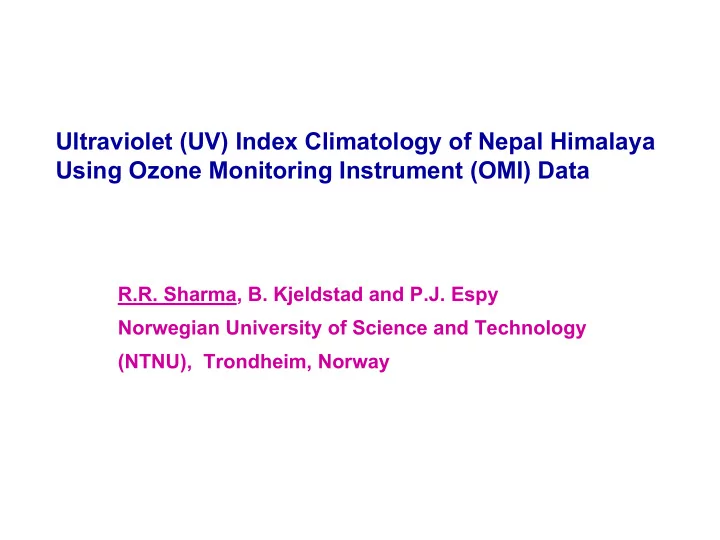

Ultraviolet (UV) Index Climatology of Nepal Himalaya Using Ozone Monitoring Instrument (OMI) Data R.R. Sharma, B. Kjeldstad and P.J. Espy Norwegian University of Science and Technology (NTNU), Trondheim, Norway
AURA-OMI • Collaborative effort between the USA, the Netherlands, the UK and Finland • Launched in July 2004 • Provides information on ozone, aerosols, clouds, surface UV irradiance (UV Index), trace gases. • Wide swath (2600 km), sun synchronous (ECT 13:42), nadir viewing (13 x 24 km ). • Orbital period ~98 min., equatorial crossing time 13:42 hour. • Global coverage
Norwegian UV monitoring stations • Nine stations from 1995/96 and 58º- 79ºN • Operation by Norwegian Radiation Protection Authority (NRPA), in co- operation with NILU. • Altitude range (10 - 1210 m) • Used multiband Filter Radiometer of type GUV (5 channel). • The calibration based on the travelling transfer standard GUV • Intercomparison, and Harmonization (±4.6% (2-sigma) for all sky conditions and SZA < 80º)
• Solar Radiation and Aerosol in Himalayan Region (SAHR) project under the Institute of Engineering of Pulchowk Campus of Tribhuvan University • Four stations 2008-2009 and 70- 2850 m • MBFR type manufactored by Norwegian Air Research Institute (NILU)
Scatter plots showing OMI and Ground UV indices of Nine stations (Bias 9-20% for cloud free/snow free cond.)
Scatter plots showing OMI and Ground UV indices of four stations (Bias 35-48% for cloud free and snow free condition).
time. coincidence measurement at satellite overpass Time series plot of OMI surface albedo Albedo 0.05 0.15 0.25 0.1 0.2 0 09.09.2008 29.10.2008 18.12.2008 06.02.2009 28.03.2009 17.05.2009 06.07.2009 25.08.2009 14.10.2009 03.12.2009 22.01.2010 13.03.2010 02.05.2010 21.06.2010 10.08.2010 29.09.2010 18.11.2010 07.01.2011 26.02.2011 17.04.2011 06.06.2011 of 26.07.2011
Plot of Lambert Equivalent Reflectivity (LER), and Cloud Optical Depth (CLDOPT) of OMI for coincidence overpass data from Nepal.
Plot showing dependence of relative differences (biases) on cloud transmission factor for Lukla station
U V In d e x 10 12 14 • Residual after the correction for clear sky condition • Empirical correction = GD/OMI = 0.633 • OMI and ground UVI for cloud free condition (left) 0 2 4 6 8 1 2 .1 0 .2 0 0 8 1 2 .1 2 .2 0 0 8 (right). 1 2 .0 2 .2 0 0 9 1 2 .0 4 .2 0 0 9 1 2 .0 6 .2 0 0 9 1 2 .0 8 .2 0 0 9 1 2 .1 0 .2 0 0 9 1 2 .1 2 .2 0 0 9 1 2 .0 2 .2 0 1 0 1 2 .0 4 .2 0 1 0 1 2 .0 6 .2 0 1 0 1 2 .0 8 .2 0 1 0 1 2 .1 0 .2 0 1 0 1 2 .1 2 .2 0 1 0 1 2 .0 2 .2 0 1 1 1 2 .0 4 .2 0 1 1 1 2 .0 6 .2 0 1 1 GD OMI R e s id u a l -3 -2 -1 0 1 2 3 0 9 .0 9 .2 0 0 8 1 9 .1 0 .2 0 0 8 2 8 .1 1 .2 0 0 8 0 7 .0 1 .2 0 0 9 1 6 .0 2 .2 0 0 9 2 8 .0 3 .2 0 0 9 0 7 .0 5 .2 0 0 9 1 6 .0 6 .2 0 0 9 2 6 .0 7 .2 0 0 9 0 4 .0 9 .2 0 0 9 1 4 .1 0 .2 0 0 9 2 3 .1 1 .2 0 0 9 0 2 .0 1 .2 0 1 0 1 1 .0 2 .2 0 1 0 2 3 .0 3 .2 0 1 0 0 2 .0 5 .2 0 1 0 1 1 .0 6 .2 0 1 0 2 1 .0 7 .2 0 1 0 3 0 .0 8 .2 0 1 0 0 9 .1 0 .2 0 1 0 1 8 .1 1 .2 0 1 0 2 8 .1 2 .2 0 1 0 0 6 .0 2 .2 0 1 1 1 8 .0 3 .2 0 1 1 2 7 .0 4 .2 0 1 1 0 6 .0 6 .2 0 1 1 1 6 .0 7 .2 0 1 1 2 5 .0 8 .2 0 1 1
• Diurnal pattern of ground measured UV index • 21 December 2010 (left) • 21 March 2010 (middle) • 28 July 2010 (right) • Lukla (2850 m, red), Kathmandu (1350 m, magenta) • Pokhara (850 m, green), and Biratnagar (70 m, blue).
Time series of monthly average UVI for all six sites of Nepal Himalayas from October 2004 to March 2012 using OMI UVI
Monthly average UV index climatology for clear sky days at local noon (with error bar ±1 σ of the standard deviation.
• Level of UV index for clear sky days at local noon for six sites of Nepal using empirically corrected OMI monthly average data from 2004-2012. • Colours are coded according to the internatonal colour codes for UV index (WHO, 2002)
Recommend
More recommend